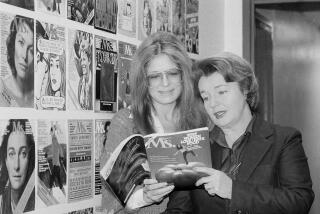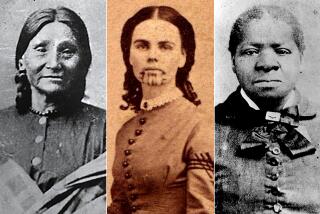An American herstory
- Share via
What a pageant! Gail Collins’ “America’s Women: 400 Years of Dolls, Drudges, Helpmates, and Heroines” sweeps across four centuries of the history of women in America in one seamless take. Collins, a former columnist and now editor of the New York Times editorial page, has gathered material from scholars and writers in an ambitious, largely successful and highly readable volume.
From the Colonists’ version of Jamestown (there being no Native American account), Collins reconstructs the story of Pocahontas -- dead at 20, leaving a small child -- as both enigma and tragedy, then moves north and 60 years ahead in time, stopping in Massachusetts to give us a front-row view, with close-ups, of the cast at the Salem witch trials. As she moves onward through time to the Revolution and then across the continent, there are captivating cameos of female leaders, victims, villains and a few who triumphed by simply surviving. Using their own words, spiced with her insights, she reveals what is uniquely American about their world.
Americans were rooted in a biblical tradition that accepted slavery and the subordination of women. Most Colonists were also locked into the English legal system, which allowed women almost no economic independence. Collins narrates the struggle of the women who successively defeated that system until, by the late 20th century, American women had won entry into almost every line of work and profession from which they had been excluded by law and custom.
Collins describes three American phenomena that shaped women’s lives. The first and most searing was slavery. Though only about half owned slaves, most Southern white women defined their status in opposition to black women and thus became the “dolls” of the subtitle, disdaining the skills they sorely needed to manage a 19th century household. In contrast, slavery made activists of a brilliant if tiny minority of Northern women, who took up the abolitionist cause and, in acts of civil disobedience, helped slaves escape to Canada. Collins focuses on Harriet Beecher Stowe and her remarkable family, noting that an escaped slave was Stowe’s model for Eliza in “Uncle Tom’s Cabin.” The outrages the slaves suffered in the South make painful reading. Their children, Collins tells us, were cared for as if they were livestock, fed from troughs like pigs or cattle. Inflamed at the injustice, a delegation of American women, including Lucretia Mott, went to the World Anti-Slavery Convention in London in 1840, where they were expelled to the gallery. Furious, Mott and her friend Elizabeth Cady Stanton -- there with her husband, Henry -- resolved to hold a convention in the United States to advocate women’s rights. At that convention, in Seneca Falls, N.Y., in 1848, the delegates included 40 men; in deference to the way things were, the women asked Mott’s husband to preside. It was not an auspicious beginning. But it was a beginning.
Abolition, however, took precedence, especially after the passage of the Fugitive Slave Act, which allowed slave hunters to track down escaped slaves in free states. Some Southern women joined the abolitionist cause, while women in the North worked to reform other social ills, attacking saloons in the cause of temperance and holding prayer vigils in front of bordellos. This public activism was itself a social revolution: Collins points out that in the Revolutionary era communities dispensed charity only to their neighbors; in mid-19th century America, she notes, “[h]elping strangers was a relatively new concept.” Still, many American women were no different from men in their prejudices: For example, a shivering woman about to give birth was turned away from a New York lying-in hospital while the women in charge checked her references; the next morning she was found barely alive, her newborn daughter’s corpse frozen to her clothing. On the Pacific coast, an Oregon woman remarked in a letter in 1852, referring to the smallpox that the settlers had brought with them, that Indians were “dying here as elsewhere.... I used to be sorry that there was so much prospect of their annihilation.... Now I do not think it is to be much regretted. If they all die, their place will be occupied by a superior race.”
The second American phenomenon was the great move West, following the discovery of gold in California in 1848. Single women joined the wagon trains along with families. Collins describes the discomfort of the passage, often six months long, with children cooped up all day, the rationing of food and water and no change of clothing until they reached their destination. Many stopped short of California, in Colorado, Wyoming or Utah. Few women panned for gold, but some found a rich lode in the hungry prospectors ready to pay as much as $5 for a home-cooked muffin. Women were scarce in the Western territories, which wooed them by passing laws giving them control of their own money and mandating equal pay for female schoolteachers. In 1869, Wyoming became the first state to allow women to vote. Weeks later Utah followed and before the century was out so did Idaho and Colorado. In 1890, when Wyoming applied for statehood, the territory’s delegate to Washington reported that congressional approval would likely depend on eliminating female suffrage, and the Wyoming Legislature wired back, “We will remain out of the union a hundred years, rather than come in without our women.” Statehood was won, but narrowly.
The third of these formative American experiences began on the East Coast with the arrival of the first wave of immigrants. Unlike their predecessors, who homesteaded farms, the Irish in the 1840s, and later Italians and Eastern European Jews, settled in towns and cities, where women found work outside their homes, in sweatshops, factories and mills. Among the contributions of these immigrants, Collins tells us, was the development of a new style of courtship. Because their tenement dwellings were so crowded, couples arranged to meet in public places, such as the newly opened amusement parks. They called these appointments “dates.” Collins notes that these arrangements, so different from the traditional middle-class, parental chaperoning, moved up through the social classes until, by the middle of the 20th century, dating defined American courtship culture.
By the turn of the century, the rate of change had accelerated. Bicycles, automobiles and increased educational opportunities (a third of all college students were female in 1880) enabled women to be independent, and for the first time many opted not to marry. The 20th century saw another change in social mores, signaled by the well-publicized divorce of Alva Belmont in 1895, who retained her place in New York’s social register after her remarriage. By the 1920s, conversations about sex were common in mixed company. It was time for women to vote, and Collins presents a down-to-the-wire account of the passage of the 19th Amendment in the last necessary state, Tennessee. The legislative chamber filled with tension when a “sure” vote for passage changed his mind. A callow 24-year-old legislator then rose to explain his own new course: He had a letter from his mother telling him to vote for suffrage, and he declared that “a mother’s advice is always safest for a boy to follow.” The panorama grows more and more familiar as Collins makes her way through the last century. For instance, she reports that the almost absolute absence of personal hygiene in earlier centuries is replaced by an interest in cleanliness; the mystery of how earlier women handled menstruation gives way to open discussion of the manufacture and marketing of sanitary products.
Collins never fails to include accounts of the condition of African American women, noting, for example, that during the 1963 March on Washington, the Rev. Martin Luther King Jr. and the other male leaders did not invite Rosa Parks to sit with them on the platform. The woman whose refusal to move to the rear of the bus triggered the bus boycott in Montgomery, Ala., was sent to the rear of the line, with the leaders’ wives.
At times, Collins wanders from the facts -- for example, she includes in a discussion of the cult of science at the turn of the last century a 1928 quotation from a psychologist advising against kissing and hugging one’s children -- and her documentation is less than adequate. But such flaws do not detract from the interest of her narrative. In the introduction, she states that the history of America’s women is a history of the struggle against a status quo of impossible, often contradictory expectations accepted by men and women both, not a struggle against men. That is probably true, but the status quo was supported by laws and customs written and enforced by men. What Collins does well is demonstrate that the struggle to establish women’s rights was carried on by both sexes.
The seismic social changes that followed the women’s movement of the 1960s have inevitably brought new issues to the fore and left some old ones unresolved. There has always been a tug of war between women who long to stay home and those who want opportunities open to them beyond their hearth. We still have our dolls -- as well-maintained trophy wives remind us -- and many recent immigrant women are still drudges in sweatshops. But helpmates and heroines abound to continue the struggle to let every woman fulfill herself as she sees fit.
More to Read
Sign up for our Book Club newsletter
Get the latest news, events and more from the Los Angeles Times Book Club, and help us get L.A. reading and talking.
You may occasionally receive promotional content from the Los Angeles Times.










